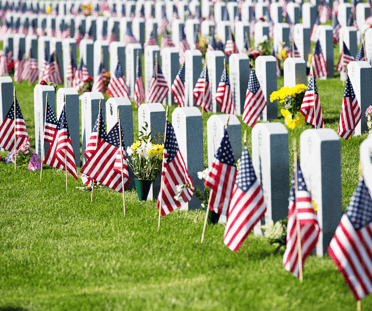Memorial Day on May 29 conjures images of hamburgers, hot dogs, swimming pools, and summertime for many Americans. But the last Monday in May serves, most importantly, as a time to honor those who died while fighting in the U.S. Armed Forces. It’s a holiday steeped in somber American history and tradition.
The day began as “Decoration Day,” following the Civil War when mourners placed flowers on the graves of Union and Confederate soldiers. Yes, Memorial Day has also come to signify the “unofficial” start of summer, but let’s remember the heroes who made it all possible.
HISTORY OF MEMORIAL DAY
The Civil War ended in the spring of 1865 when Robert E. Lee surrendered the last major Confederate army to Ulysses S. Grant at the Appomattox Court House. Over 620,000 soldiers died in the four-year conflict. General John A. Logan of the Grand Army of the Republic (an organization of Union veterans) would eventually select May 30, 1868, as a day to pay tribute to the fallen:
“The 30th of May, 1868, is designated to with flowers, or otherwise decorating the graves of Soldiers who died in defense of their country during the late rebellion, and whose bodies now lie in almost every city, village, and hamlet churchyard in the land…”
Logan chose May 30 because flowers would be in bloom all over the country. By the end of the 19th century, Memorial Day ceremonies were being held on May 30 throughout the nation. States passed proclamations, and the Army and Navy adopted rules for proper observance at their facilities.
By 1890, each Northern state had made Decoration Day an official holiday. But this was not the case in the South, where states continued to honor their dead on separate days until after the First World War.
The May 30 date was held for decades. But, in 1968, Congress passed the Uniform Monday Holiday Act, which established Memorial Day as the last Monday in May to create a three-day weekend for federal employees. The change took place in 1971. The same law also declared Memorial Day a federal holiday.

Today, Memorial Day is marked by a range of traditions and observances that vary across communities. From parades and ceremonies to the symbolic act of displaying the American flag at half-staff, these gestures serve as visible reminders of our collective gratitude. Many people also visit cemeteries and memorials to pay their respects. Engaging in these traditions allows us to actively participate in the commemoration of our heroes.
Memorial Day is a time to honor the courageous men and women who have laid down their lives in defense of our country. It is a day for us to reflect on their sacrifice, express our gratitude, and ensure that their memory lives on. As we enjoy the long weekend and come together with loved ones, let us not lose sight of the true meaning...
May we always remember, honor, and cherish the heroes who made the ultimate sacrifice for the land we call home.





Leave a Comment